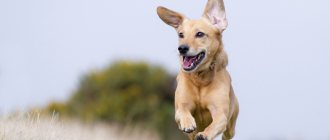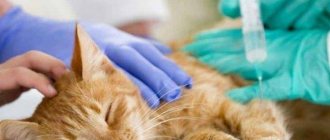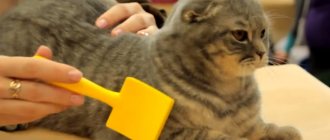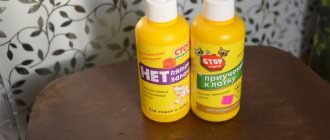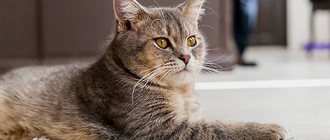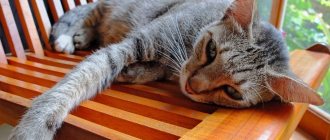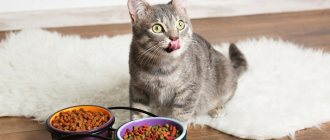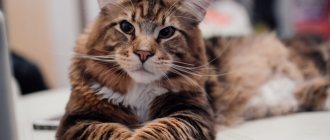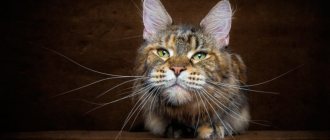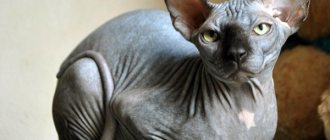Is it necessary to use general anesthesia for dogs and other animals?
Knowing the serious consequences, you always want to bypass general anesthesia, namely, make it local - acting in a specific part of the body. But, this is only possible for minor procedures: stitching up the skin for minor damage, removing a tiny growth, or trimming an ingrown claw.
But before sterilization, it’s definitely not possible to do only epidural anesthesia. Animals are not people, and they certainly will not lie motionless until the end of the operation. And the reason for this is fear.
And it will also not be possible to properly brush your teeth without general anesthesia - the pet is so stressed that not a single local anesthesia will keep a panicking animal on the doctor’s table. Therefore, for operations and many procedures, pets need to use general anesthesia, and sometimes complex.
How long does it take for a cat to recover from anesthesia?
Ordinary yard cats and male cats recover from anesthesia faster than purebred cats. Artificially bred animals often have cellular mutations that weaken the immune system. The hardest time is for the British, Siamese, Himalayans, Bengals and Sphynxes.
In addition to breed, age and general health are important. A kitten without pathologies will tolerate the procedure easier than an adult pet with chronic diseases.
On average, wake-up time is 2-8 hours. Restoring for an entire day is acceptable, but is an exception.
The amount of incoming anesthetic is reduced 10 minutes before the end of the procedure. The safest type of anesthesia is gas. It does not settle in the internal organs and completely leaves the body through the lungs during breathing. This drug is recommended for animals with kidney and liver pathologies. It costs more than its injection counterparts, but is superior to them in terms of weathering speed and safety.
In addition to the type, the quantity of the drug is also important. The lowest dosage is used for castration and dental treatment.
Pitfalls after using general anesthesia for dogs, cats, rodents and ferrets
We are sure that you have heard more than once from friends or read on the Internet about how difficult it is for pets to recover from anesthesia - for about a day the animal mostly lies down, whines or meows (cries), the pet with a shaky gait cannot confidently move around the apartment, often falls and hits the corners, and after drinking water or food, vomiting immediately occurs.
This condition always occurs after the use of anesthesia in the form of intramuscular drugs, because it is impossible to immediately “cleanse” the bloodstream of injected substances - this requires a lot of time and effort from the body itself.
The disadvantages of using such drugs also include a complete lack of control over anesthesia. Once the drug has been administered intramuscularly to an animal, in emergency situations it is no longer possible to suspend or completely cancel its absorption. And this can lead to very disastrous consequences.
But this type of anesthesia is still used by many veterinary clinics, because for them it:
- financially accessible;
- faster to use;
- carried out without additional equipment;
- does not require the services of an anesthesiologist (because there is nothing to control).
But all these advantages are good not for the owner, but for veterinary clinics, since all the consequences of such anesthesia remain behind the scenes - the pet and its owner are already at home faced with the difficulties that arise after anesthesia.
But the prevailing stereotypes are not at all relevant if inhalation anesthesia is used in a veterinary clinic.
Pulmonary edema in a cat after sterilization
Long gone are the days when pets were anesthetized “by eye,” and the owners begged the doctor “not to overdo it.” Now veterinary clinics have modern and safe means of anesthesia. Large clinics use inhalation anesthesia and epidural anesthesia. Despite this, general anesthesia can cause dangerous complications in cats after sterilization.
If your cat has problems with the heart muscle (hypertrophic cardiomyopathy, congenital defects), pulmonary edema or thromboembolism may develop after surgery. Both complications can lead to the death of the animal, even if the owner notices something is wrong in a timely manner and consults a doctor.
As a doctor, I recommend doing a cardiac ECHO (ultrasound) before surgery. So we can be calm or, on the contrary, look for options for anesthesia and medicinal support. In practice, owners most often refuse the study to cut costs. With the words “Yes, this is a cat, what will happen to her.” To be fair, I note that most cats do tolerate anesthesia well. But there are breeds in which HCM (hypertrophic cardiomyopathy) occurs much more often than in outbred cats. Here are some popular cats that are at risk:
- Maine Coons;
- Sphinxes;
- British cats;
- Scottish cats.
Scottish Fold ECHO of the heart is a must
Owners should monitor their cat for at least two weeks after sterilization. The pet should eat, drink, and play as usual within 24 hours. If a cat refuses to eat, lies in one place, breathes with its mouth open like a dog, you should immediately contact a well-equipped clinic for diagnosis.
Features of inhalation anesthesia
Inhalation anesthesia is the sound sleep of an animal (general anesthesia), which is achieved due to gaseous substances entering the respiratory tract in certain doses and concentrations.
From the respiratory tract, through the pulmonary circulation, the drug used enters the brain, gently inducing reliable, controlled sleep.
Thus, the volatile substance used does not enter the systemic circulation, which means that inhalation anesthesia cannot have a negative effect on the internal organs of the abdominal and pelvic cavities.
Upon completion of the gas supply, the drug easily leaves the parts of the brain in a matter of minutes, then returns through the pulmonary circulation to the lungs and is exhaled outward.
Therefore, after such anesthesia, the animals are taken home in full consciousness. After just a couple of hours, the pet moves confidently, leads its normal lifestyle and may ask for food.
Little patient at an appointment with a veterinarian-anesthesiologist
Hence the conclusion: the volatile drug used does not linger in the animal’s body, and therefore does not cause serious consequences during the recovery period. This fact minimizes the time spent on care and makes it easier for the owner to care for the pet.
Modern drugs for anesthesia of cats
At CityVet veterinary clinics, doctors systematically undergo internships and advanced training courses in the field of anesthesiology. In our work, we use modern anesthesia drugs that have passed all the necessary tests and are certified for use in anesthesia for cats. Among general anesthesia, we give preference to drugs based on propofol, medetomedine, isoflurane, zolazepam and tiletamine.
What anesthesia is best for cats? No anesthesiologist can give a definite answer to this question. All drugs are selected taking into account the physiological and breed characteristics of the animal, age, based on the results of the preoperative examination and the surgical plan.
Gas anesthesia for cats is one of the safest means of general anesthesia today. The main drugs for inhalation anesthesia are isoflurane and sevoflurane. Drugs for inhalation administration have very little effect on the cat’s internal organs, are less toxic and are used by veterinary anesthesiologists for severe concomitant diseases (for example, cardiovascular pathology).
When seeking surgical help at our clinics, you can be sure that your cat is under the careful supervision of qualified specialists. We recommend that all animals requiring surgical intervention undergo preoperative examination and do not refuse to place the cat in the hospital after completion of the operation. By listening to our advice, you will be confident in the health of your pet, because your cat will receive high-quality medical care without consequences for its body.
After the operated cat returns home, it should be placed on a warm bedding placed on the floor and ensure that there are no drafts in the room. After anesthesia, the animal should not be placed on a sofa or chair, since its movements at this time will be uncoordinated, as a result of which the cat may fall from a height. There should be no sharp or hot objects, wires or threads on the floor, as well as other things in which she could become entangled.
After anesthesia, the cat should lie only on its right side, since lying on the left puts additional stress on the heart after surgery.
It is very important to ensure that your cat's eyes do not dry out. After the operation, she will not be able to blink on her own, so you need to instill a special solution under her eyelids and close/open them with your fingers every half hour until the cat begins to blink on her own. She will also have a dry mouth - wetting her tongue with water or carefully pouring droplets of water from a pipette into her mouth will help to cope with this - but very carefully so that the cat does not choke. Inappropriate behavior of the animal is also noted after anesthesia - this occurs due to its disorientation and is normal in most cases. However, if the cat is really unwell, you need to urgently call the veterinarian who performed the operation.
Is inhalation anesthesia the safest for cats, dogs, rodents and ferrets?
Inhalation anesthesia is increasingly used in some veterinary clinics for:
- sterilization of cats;
- sterilization of dogs;
- castration of male and female cats;
- complex surgical operations;
- endoscopic studies;
- hygienic teeth cleaning and other dental procedures.
However, no anesthesia can be 100% safe for an animal.
But the risks to your pet’s health may vary depending on the type of anesthesia, and with inhalation anesthesia (gas anesthesia) these risks are minimal. Still, it is more correct to say that inhalation anesthesia is anesthesia that the anesthesiologist perfectly controls, manages and can completely remove the animal from it at any time in case of emergency.
Alisavet has a full-fledged surgical team
The significant advantages of inhalation anesthesia give it undeniable advantages over other types of general anesthesia:
- possibility of precise dosing of the gas mixture;
- exceptional reliability thanks to a whole range of equipment;
- the speed of onset of quality sleep in your pet;
- acceptable use for several hours;
- rapid recovery from anesthesia in 5-10 minutes;
- absence of a difficult recovery period in animals, due to the peculiarities of the use of gas anesthesia.
03/09/18 Safe anesthesia. Inhalation (gas) anesthesia.
Veterinarians of the Alisavet network of clinics comply with all the necessary generally accepted requirements for anesthesia, thereby minimizing possible negative consequences.
Post-anesthesia care
During the period of recovery from anesthesia, the cat may suffer from involuntary urination or vomiting, so you need to monitor it very closely - if it starts to constantly lick itself, you need to lay a newspaper or place a bag on it. Feeding can begin only after 24 hours, while the animal’s poor appetite may persist for several more days. The cat will be able to fully drink water after 3-4 hours.
After sterilization, a special blanket is put on the cat, which she will have to wear for 10-14 days until the stitches are removed.
To treat healing stitches, you need to regularly remove this blanket from the hind legs and immediately put it back on after treatment so that the cat does not lick the stitch wounds. In addition, you need to carefully ensure that the animal does not try to jump on a hill, since due to weakness it may not be able to jump and get caught on something in the blanket, hanging in it. Naturally, the cat will begin to squirm, trying to get out, as a result of which the seams will simply come apart.
The main purpose of anesthesia
is the inhibition of human reactions to surgical trauma.
This is not only medicinal sleep, but also pain relief, and muscle relaxation or muscle relaxation. Awakening after anesthesia
is no less important stage, because...
at this time, patients gradually restore their vital processes. Patients may be inadequate for some time after anesthesia. To prevent complications of anesthesia
, anesthesiologists monitor the patient even after the operation is completed.
Instructions
Remember that the recovery time is at least 1.5-2 hours, while the anesthetic drugs are in effect, during this time you must be under the supervision of an anesthesiologist-resuscitator in the intensive care ward. You may feel pain in the area of the postoperative wound, accompanied by nausea and your wakefulness and sleep patterns may be disrupted. To prevent aspiration, you should lie on your side or with your head turned to the side for some time.
Remember that early activation prevents thromboembolic complications of soft tissues. You should try to start moving as early as possible, turning on your side, sitting down in bed, and getting out of it. Hypostatic pneumonia is also prevented by physical activity and vibration massage.
Please note that the first 2-3 hours after anesthesia
You can't drink or eat. You will only be able to drink water or unsweetened fruit juice. And eat food only the next day to avoid additional problems with intestinal upset. If you feel an attack of vomiting, try to turn on your side, and be sure to rinse your mouth after it.
An obligatory component of the early postoperative period is pain therapy. They are prescribed only by the attending physician. Remember that all these drugs have many side effects, and some of them can lead to mental and physical dependence. Therefore, you should not abuse them.
For short-term and minor operations in veterinary medicine, non-inhalation anesthesia is used. During this procedure, the animal is administered an anesthetic drug intravenously. If the operation requires long-term surgical intervention, inhalation anesthesia is used.
Instructions
Anesthesia is an artificially induced sleep that is used in veterinary practice to perform surgical operations on animals. Anesthesia is accompanied by loss of sensitivity, loss of reflexes and muscle relaxation. In addition to operations, anesthesia is often used for veterinary examinations of animals.
Anesthesia is usually divided into several stages. During the first stage, the animal experiences analgesia—loss of pain sensitivity. The second stage is characterized by excitement and occurs differently in different animals. It is expressed in increased motor activity - the animal tries to free itself from the anesthesia mask or fixing bandages. The third stage of anesthesia is called surgical. During this period, the animal begins to sleep peacefully, the pupils narrow and stop responding to light. The operation begins only when this stage occurs.
In veterinary practice, non-inhalation anesthetics are most often used - various barbiturates, the drugs Methoxyton, Rompun and Rometar. Anesthetics of the barbiturate group can have both long-term and ultra-short action.
Non-inhalational anesthetics are administered intravenously. The solution is administered slowly, monitoring the condition of the animal. Typically, anesthesia occurs within a few minutes after the start of the injection. Upon reaching the surgical stage of anesthesia, the animal takes a deep breath, after which sleep occurs. After this, the administration of the anesthetic is reduced or stopped.
In the case of most anesthetics from the barbiturate group (hexenal, sodium thiopental), narcotic sleep lasts no longer than 20 minutes, so such drugs are suitable for minor operations.
In veterinary medicine, drugs based on xylazine (Rompun, Rometar) are also used for non-inhalation anesthesia. These drugs have a calming and analgesic effect. They can be administered either intramuscularly or intravenously and allow minor surgical operations to be performed.
If a long and traumatic operation is required, inhalation anesthesia is used. In modern veterinary medicine, nitrous oxide, medicinal ether and some other substances are used for inhalation anesthesia. As a rule, special anesthesia machines are used for non-inhalational anesthesia. For ether anesthesia, you can limit yourself to a simple anesthesia mask soaked in medical ether. The mask is placed on the animal's face and it inhales ether vapor until it falls asleep.
Video on the topic
Before sterilizing a cat, the owner must learn all the details of the upcoming operation, contraindications and consequences. It is important to familiarize yourself with how to care for your pet, what to feed, and how to treat a suture after surgery.
Inhalation anesthesia for rodents and ferrets
The most delicate pets at Alisavet are given inhalation anesthesia
All three stages of creating gas anesthesia are carried out in these animals. However, there are small peculiarities here. Inhalation anesthesia for small rodents is also carried out after premedication. In hamsters and rats, a tube is not inserted into the trachea, so the gas mixture enters through a special mask.
Ferrets and large rodents (guinea pigs, rabbits) are first given premedication, after which an intravenous catheter is installed, and then a gas mixture is also supplied using special masks.
03/09/18 Anesthesia for rabbits. Inhalation (gas) anesthesia
Is inhalational anesthesia allowed for everyone?
There is always at least one contraindication for the use of any substance. And that's okay.
The veterinarian will NOT use inhalational anesthesia if your pet has:
- bronchial asthma;
- bronchitis and any lung diseases;
- any lesions of the trachea;
- increased intracranial pressure;
- traumatic brain injuries and in general any pathologies associated with the brain.
After a thorough preventive examination, a veterinary anesthesiologist may allow the animal to undergo inhalation anesthesia if:
- the pet does not have the above diseases;
- during laboratory testing, blood counts are within acceptable limits;
- there is no prohibition from a cardiologist after an ECG or ECHO (ultrasound of the heart);
- Gas anesthesia is indeed advisable (simple and quick procedures are sometimes performed under local anesthesia).
Inhalation anesthesia can be performed on examined pets at any age - both very young animals (kittens, puppies) and very elderly ones.
But you need to remember that only an anesthesiologist can decide what type of anesthesia to administer to a particular animal and what drugs to use - most often it also depends on the anesthetic risk (ASA scale), age, breed and scale of the operation.
Complications after surgery
If the operation is prepared correctly and appropriate care is provided to the animal, complications can be avoided, but the individual characteristics of the cat can make adjustments. If your pet exhibits alarming symptoms, you should urgently take it to a veterinarian:
- the appearance of a rash and swelling of the cat’s eyelids, lips and tongue;
- suture bleeding;
- redness or pallor of the mucous membranes;
- arrhythmia or bradycardia;
- significant decrease or increase in body temperature;
- heavy breathing with wheezing.
Any unusual situations associated with the operation are extremely rare, but it is necessary to know what complications may arise after sterilization of a cat.
© shutterstock
Why and how do you prepare an animal for inhalation anesthesia?
When an unexamined animal ends up on the operating table, the surgical team actually faces a “time bomb” - specialists do not know what still hidden diseases may make themselves felt now during the operation or later after some time. Consequently, doctors cannot prepare in advance for possible problems, and the worst thing is that the anesthesiologist begins to perform his work only according to certain standards, and not individually, according to the condition of this particular patient.
The lack of preliminary diagnosis before using anesthesia immediately increases the risks during operations or complex procedures, as even scientific research shows.
Preparing cats and dogs for inhalation anesthesia, as a rule, is no different from the usual preoperative examination - everything is the same as if the anesthesia was intramuscular or only intravenous:
- ECG or ECHO (ultrasound of the heart) - it depends on the type of pet;
- laboratory blood tests (general and biochemical tests).
Preparing an animal for inhalation anesthesia at Alisavet
These preventive procedures can be done either a few days or a few minutes (rapid tests) before the use of inhalation anesthesia.
Important! There are some breeds of animals that require a preliminary chest x-ray examination. For example, the West Highland White Terrier needs this because they are susceptible to idiopathic pulmonary fibrosis. The veterinarian will definitely tell you about the need for additional examinations during the preliminary examination.
What is anesthetic risk?
No matter how experienced the surgeon and anesthesiologist are, there is always the possibility of complications, even death. Anesthesia for cats is a serious burden primarily on the cardiovascular and respiratory systems. Minimizing anesthetic risks is the task of the veterinarian, who is obliged to individualize the standard regimen taking into account the characteristics of a particular cat. In many cases, the serious condition of a cat after anesthesia is a consequence of the use of drugs “at random”, without studying the condition of the mustachioed patient. To avoid problems, it is important to contact only competent specialists with an excellent reputation.
What to do after turning off inhalation anesthesia
Immediately after the operation or procedure, the animal is disconnected from gas anesthesia. As soon as the cat or dog shows the first signs of waking up, and the doctor understands that the pet can breathe on its own, the endotracheal tube is carefully removed.
After this, the animal is moved to an oxygen box, where it lies under the constant supervision of an anesthesiologist until it fully awakens.
Pet after waking up
While the pet has not yet fully regained consciousness, the doctor gives the necessary injections: long-acting anesthesia and other drugs necessary for the situation.
If sterilization or other abdominal surgery was performed, the cat or dog is immediately put on a postoperative blanket.
Only after the anesthesiologist is sure that the animal is completely stable (breathes smoothly on its own, feels well, is not in pain), then only then do we hand the pet over to its owner.
After inhalation anesthesia at Alisavet, it was as if nothing had happened
Unless there are any special situations, the animal is usually allowed to eat and drink 4 hours after inhalation anesthesia.
Thus, the task of the anesthesiologist is to ensure that the pet is very gently immersed in anesthesia, undergoes all the necessary manipulations and also gently comes out of anesthesia. After regaining consciousness, the animal does not remember anything, which means that there simply cannot be any negative emotions in the future.
03/09/18 Effect of anesthesia on the nervous system (brain)
Constipation in a cat after sterilization: what to do, why it occurs
I always warn my patients: after sterilization, the cat should pee regularly, but at first there may be no stool. If after 3 days the pet does not go to the toilet in a big way, you need to take action.
There are several reasons for intestinal dysfunction. Firstly, this is a long-term starvation diet. Before anesthesia, you can feed the cat 10-12 hours. But if the operation is scheduled for the middle of the day, owners can increase this interval (do not feed the cat in the middle of the night!). Plus, the cat does not receive food for some time after the operation. As a result, she simply has nothing to poop with; it takes time for feces to form.
The second reason is the effect of drugs that are used for anesthesia in cats. Agents for intramuscular anesthesia (Domitor, Rometar, xylazine) not only significantly reduce body temperature in animals, but also affect the motility of the digestive tract. Because of this, intestinal peristalsis on the first day after surgery may be sluggish, and vomiting is possible.
The third reason for constipation after sterilization is simple stress associated with a trip to the clinic, surgery and wearing a blanket. Clothes can irritate your cat and make it difficult for you to get comfortable in the litter box.
If on the 3-4th day after the operation there is no long-awaited pile in the tray, you need to give the cat a mild laxative. It could be:
- A teaspoon of petroleum jelly (about 3 ml)
- A tablespoon of condensed milk half and half with water.
Vaseline oil is given twice a day until the cat has a bowel movement. This is liquid paraffin, the product has no taste or smell, and most importantly, it is not absorbed at all in the digestive tract. It is sold in human pharmacies, no other oil is suitable!
Why is inhalation anesthesia more expensive than regular anesthesia?
In order to put an animal under anesthesia by administering drugs intramuscularly or only intravenously, only a few specific drugs are required. The only personnel needed is essentially a veterinary surgeon. It is this doctor who will calculate the doses, administer medications, monitor the pet’s condition and at the same time perform an operation or any procedure.
But in order to provide the animal with high-quality and controlled sleep by introducing a gas mixture, it is necessary to provide the veterinary clinic with a whole set of equipment and assemble a surgical team.
First of all, you need the device itself for inhalation anesthesia and a gas mixture in special cylinders.
Also, to monitor the condition of the animal, the following equipment is required:
- special sensors;
- heart monitor;
- pulse oximeter;
- capnograph.
This is the only way an anesthesiologist can monitor and regulate each component of anesthesia. Any deviations from the norm and the appearance of pain in the pet will be immediately visible on special monitors. This will allow the doctor to adjust the amount and speed of delivery of certain drugs.
But this is not enough. To properly use the above equipment and consumables, you need specially trained personnel - these are veterinarians, anesthesiologists and resuscitators .
A specially trained anesthesiologist plays a huge role from the very beginning of preparing the animal for surgery (or a complex procedure) until it comes out of anesthesia and completely stabilizes the body.
This task cannot be undertaken by a surgeon, since it is simply impossible to combine two complex tasks in one person. A veterinary surgeon must be focused on his work, namely, on an operation or any procedure.
But that's not all. A veterinary assistant is an important link in the surgical team, which links the overall work and promptly helps at any stage.
To carry out inhalation anesthesia, you need to involve at least three specialists and provide the clinic with a whole set of expensive equipment and consumables.
Of course, this initially requires large financial costs on the part of the veterinary clinic, so such a service cannot be equivalent to the cost of injectable drugs that are used for conventional general anesthesia.
But despite such a complex process and high financial expenses, inhalation anesthesia is many times more justified, because for a pet it is an easy way out of anesthesia, and for the owner it is easy post-operative care and a minimum of stress.
Sterilization of a cat at the Alisavet veterinary clinic in Butovo
Internal bleeding in a cat after sterilization
The veterinarian places ligatures on the vessels supplying the ovaries and uterus before removing the reproductive organs. If such a ligature comes off, internal bleeding will occur. This probability is extremely low, and many clinics use vascular electrocoagulation technology instead of threads.
Life-threatening bleeding can occur if your cat has a blood clotting disorder. This is possible with rare congenital pathologies, or with a fatal coincidence of circumstances. On a free range, a pet can catch and eat a mouse that has been poisoned but is still alive. As a result, the cat is poisoned with an anticoagulant, which leads to spontaneous bleeding.
Signs of internal bleeding:
- The cat is lethargic, weak, inactive;
- The mucous membranes (gums) are white;
- Dyspnea.
In the clinic, the diagnosis can be confirmed using an ultrasound - fluid in the abdominal cavity after surgery indicates bleeding. If ultrasound diagnosis is not possible, a diagnostic puncture of the abdominal cavity is performed with a regular syringe.
Treatment consists of blood transfusions, plasma substitutes, and the administration of hemostatic drugs. If necessary, a repeat operation is performed to find and ligate the bleeding vessel.
The cat comes to life after sterilization
Important Takeaways
Some operations are performed only once in a lifetime (sterilization of a dog, sterilization of a cat, castration of a male or female cat), so let this surgical intervention be carried out in excellent conditions and with fully controlled anesthesia.
Take the time to find a veterinary clinic that offers gas anesthesia, and don’t skimp on traveling if the chosen facility is far from you. It's worth it!
Easy awakening after inhalation anesthesia
And if any procedure (for example, brushing teeth) or surgery (for injuries and other pathologies) must be performed more than once for forced reasons, then choosing inhalation anesthesia at some point may simply save the life of your cat or dog.
